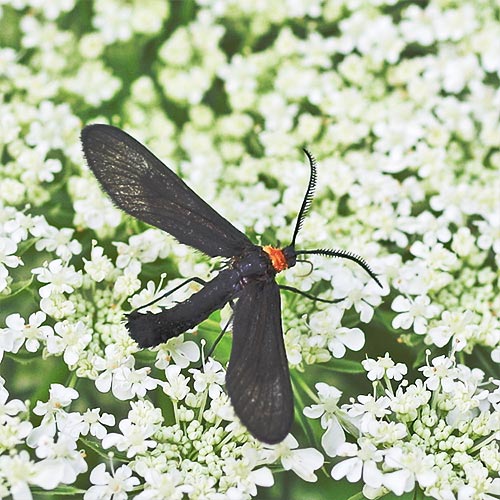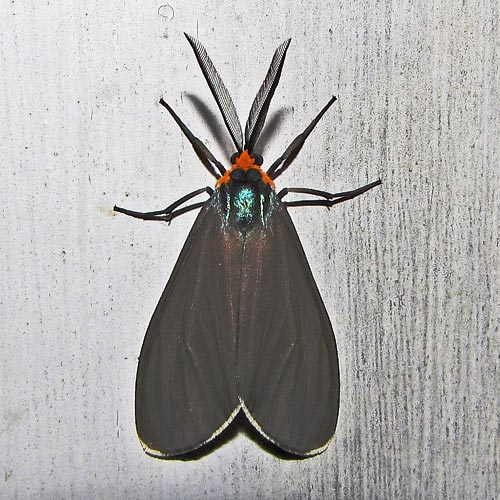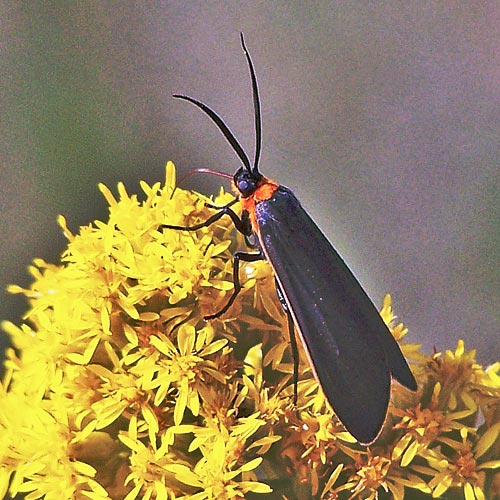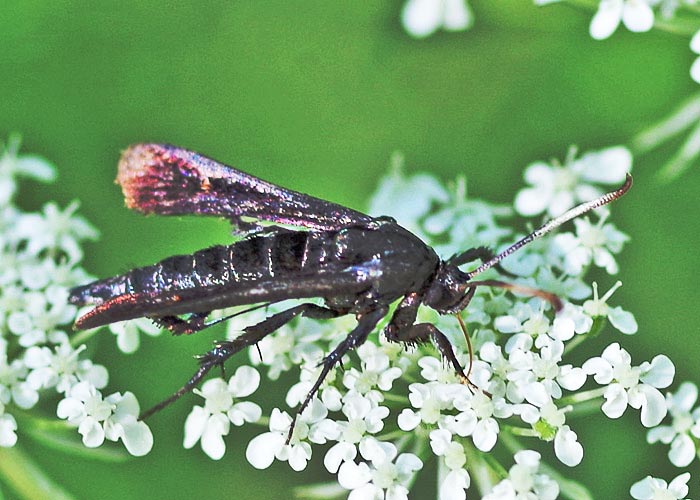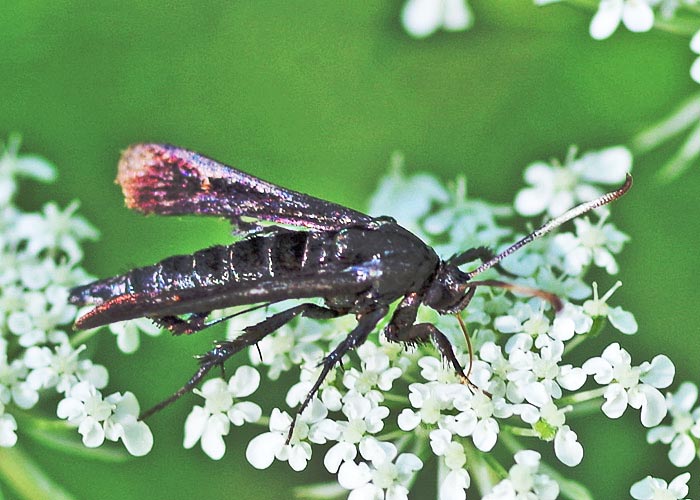Howdy, BugFans,
The two moths that star in this episode are the Grapeleaf Skeletonizer Moth and the Virginia Creeper Clearwing. They are not related to each other (other than their shared Lepidopteranism), but they have a number of things in common.
Grapeleaf Skeletonizer
Caterpillars of the Grapeleaf Skeletonizer, despite their name, feed on the foliage of Virginia creeper and Boston ivy (both members of the grape family) and, oddly, Redbud (a non-grape shrub), as well as the leaves of grapes (they like native grapes but appreciate some of the tender, imported varieties, too). As their name suggests, they skeletonize leaves by feeding as young caterpillars on the softer tissues between the tough leaf veins, and graduating to the smaller veins as they grow, leaving little of the leaf by the time they mature.
Ms. Grapeleaf Skeletonizer Moth (Harrisina americana) lays her eggs in bunches on the underside of a leaf, and in bunches her caterpillars feed, at least through the first half of their larval lives. They often chow down in a line, “shoulder to shoulder, backing away from the skeletonized portion of the leaf, standing on their future meal.” As older larvae they drift apart and feed solo, and they overwinter as a pupa in the dead leaves below their food plant. The very-short-lived adults can be seen day or night, often nectaring on flowers (males are early risers and are active around dawn).
The BugLady is looking forward to finding some of these really spiffy caterpillars on the wild grape and Virginia Creeper that are growing like kudzu over everything this year. She will turn the grape leaves over carefully though%mdash;contact with the caterpillars’ hairs results in a rash.
GSMs are in the moth family Zygaenidae, the Leaf skeletonizer moths, a.k.a. the Smoky, the Burnet, or the Forester Moths. An interesting family trait is their ability to produce hydrogen cyanide, which makes predators think twice. Many insects are toxic because of chemicals they consume in their food plants. Some Zygaenid family members do feed on plants that contain the glycosides they need as cyanide building blocks, but apparently, they can manufacture the chemical even when it’s in short supply in their environment. So, the un-camouflaged appearance of caterpillars and adults is aposematic or warning coloration.
Adult GSMs share their color scheme with the Yellow/Orange-collared Scape moth (its official name is “Yellow” but it should be “Orange”) and the Virginia Ctenucha/Ctenuchid moth (the “C” is silent). Both are in the Tiger moth family Erebidae, both are also pictured here, and both are probably cashing in on the GSM’s toxicity (it’s called Mullerian mimicry). If you look at the wing shape and “attitude,” the GSM looks less “triangular” and more “ragged” than the tidy Scape and Ctenuchid moths. The GSMs’ wingspread is about an inch, and they hold their wings out when at rest (the Ctenuchid and the Scape Moth fold their wings). GSMs are described as having feathery antennae and wings that are four times longer than they are wide. And an orange collar. And an upturned “bustle” (a bilobed caudal tuft).
Are they considered a pest in vineyards? Commercial growers apply enough pesticides in general so that GSMs are only a minor annoyance, but home growers sometimes have problems with the caterpillars. Since the younger larvae feed communally, hand picking the afflicted leaves may be sufficient. The bacterial insecticide Bt (Bacillus thuringiensis) is effective, although, as one Extension bulletin put it, Bt “is not toxic to humans, our pets, birds, and insects other than larvae of butterflies and moths” [emphasis, the BugLady]. The BugLady does not like collateral damage.
Virginia Creeper Clearwing
Just in case irritating hairs and hydrogen cyanide aren’t enough, the GSM has another line of defense. It is, like the Virginia Creeper Clearwing, a wasp mimic, a handy thing for a day-flying moth (it’s called Batesian mimicry). In fact, when she photographed the Virginia Creeper Clearwing (Albuna fraxini), the BugLady initially thought that she was photographing an unusually cooperative wasp (she’s been chasing the totally uncooperative ichneumon wasp Gnamptopelta obsidianator recently, but that’s another story).
In Moths and Caterpillars of the North Woods, Sogaard says about the Clearwing moth family Sesiidae that “some clearwing moths are so convincing in their resemblance to wasps, both in appearance and behavior, that this accounts partly for their infrequent collection.” Sesiid caterpillars typically bore into woody vines, roots, stems, or trunks, or herbaceous plants. There are about 130 species in North America (many more elsewhere) and 25 in the Upper Midwest, and the family includes some of the most awesome insects around. Check out …
- Melittia – Melittia cucurbitae
- Melittia gloriosa Hy. Edwards
- Pennisetia marginata – Sesia tibiale
- Synanthedon polygoni
- Clearwing Moth – Synanthedon arkansasensis.
According to Sogaard, the moth’s front wings are narrower than the rear wings. The “Clearwing” part of the Clearwing moth/Virginia Creeper Clearwing’s name refers to portions of the wings that have no scales. A bit of the clear hind wing can be seen peeking out from under this moth’s dark front wing (the equally-amazing hummingbird clearwing moths belong to the sphinx moth family, and they also have transparent areas on their wings).
As its common name suggests, the VCC larva feeds on Virginia Creeper/Woodbine, from within the roots. According to bugguide.net, the species name fraxini comes from the ash tree genus Fraxinus, and is based on early reports of caterpillars feeding on ash. Although there are Sesiid species that specifically target ash trees, Bugguide says that no one has noted an association of this species with ash for the past 70 years (several on-line sources do list ash trees as host plants for VCCs). Adults are found nectaring on flowers.
When it’s time for romance, Ms. VCC emits a pheromone to attract a mate, then oviposits on the outside of the host plant. The newly-hatched caterpillars bore inside, feed there, and then overwinter as mature larvae.
The BugLady
